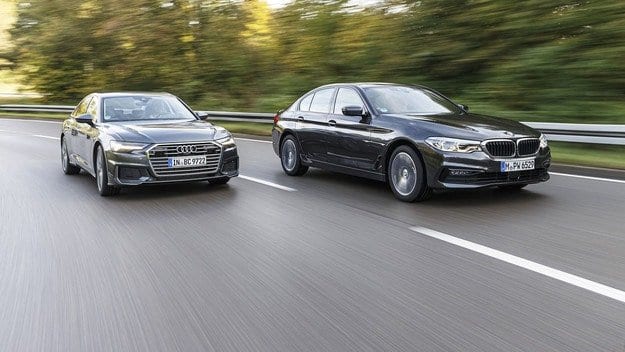
Test drive Audi A6 45 TFSI and BMW 530i: four-cylinder sedans

Two first-class sedans - comfortable and powerful, despite the four-cylinder engines.
Do you want to afford something special? Welcome then – here are two real treats: the Audi A6 and the BMW Series 5, both models with petrol engines and dual transmissions are tested. They promise driving in the most enjoyable way.
It is no coincidence that in English and other languages the term "limousine" is associated with the most luxurious cars, often driven by a professional driver. Also in Germany, where the word basically means "sedan", the limousine is a symbol of easy travel - even when the owner is behind the wheel. Models such as the Audi A6 and the BMW 5 Series confirm this thesis - in them people like to drive themselves and others as far as possible. Another reason for this is that these sedans have a very good balance of interests between those sitting in front and behind: the passenger primarily wants comfort, and the driver mainly wants lightness and lightness. Accordingly, a high-end car combines refined comfort with noticeably good handling.
After several longer journeys, you find that both Audi and BMW are moving towards the classic luxury car quest to protect passengers from any inconvenience. In this regard, the business class as a whole has successfully caught up with its fantasies of dynamics and dynamics. he is in a comfortable reality, aware of himself.
However, in the Audi A6 and BMW "Five" you can easily overcome quite difficult tracks. Both sedans achieve high cornering speeds with little steering effort. At the same time, you never fail to feel the proper composure - after all, driving a large sedan should never be trivialized towards a small hatchback.
Make yourself this gift
Both Audi and BMW exude a harmonious ambience in their interiors, where leather adds subtle touches - at an additional cost. Surcharge? Yes, despite the high base prices, animal seats are not standard. In principle, you need to invest a lot of money to get rid of the "charm" of a company car in the basic version. For example, when ordering decorative open-pore wood planks. Or comfortable seats worth taking care of - like acoustic glazing.
If desired, the "five" can be equipped with digital controls Live Cockpit Professional and a central touchscreen display. On it can be projected virtual innovations of the seventh generation of the function management system, which will be introduced with the modernization this year.
Unfortunately, even now, the peculiar design of the speedometer and tachometer impairs intuitive readability. The good news is that the iDrive system itself is not susceptible to these ailments - controlling functions using a push-pull controller distracts the driver from the movement much less than touching fields and sliding a finger across Audi screens.
Undoubtedly, a good investment is the money invested in adaptive dampers. In this price range, they should be available by default, but here they have to be paid in four figures. However, they are absolutely essential. The praise of the luxurious mechanism at the beginning of this text would be unthinkable without their participation - first-class suspension comfort should be something that comes naturally to a business class car. However, some financial restraint could be exercised in the choice of wheels.
Audi sent the A6 45 TFSI Quattro with 20-inch wheels (€2200) to the test, BMW were pleased with the 530-inch 18i xDrive (standard on the Sport Line) and received a corresponding score for driving comfort. BMW's Five quietly absorbs bumps, reporting them along the way, instead of making them the main topic, as the Audi A6 does. Its slightly pulsating response would probably have been better if smaller diameter rims had been left. However, the people of Ingolstadt seem very eager to highlight their child's talent for good road dynamics. Therefore, the test car was additionally equipped with all-wheel drive; this ambition is rewarded with higher slalom speeds and belt changes.
Energetic and nimble
On a secondary level, however, the efforts of the chassis designers are no longer perceived equally because the BMW model seems to be more energetic and agile. A glance at the scale confirms this impression - the five-wheel drive, which also has all-wheel drive and steering, is 101 kilograms lighter than the Audi A6, accelerates one idea faster from standstill to 100 km / h and achieves a little more. nimble overtaking process. Perhaps the more vigilant nature of the engine plays a big role here.
The models we're comparing here are called the 45 TFSI Quattro and 530i xDrive, and in both cases, the numerical designations can contribute to purely wishful thinking. Otherwise, both models are forced to settle for two-liter four-cylinder engines. In the BMW sedan, the turbocharged engine has 252 hp. and produces 350 Nm, Audi has the corresponding figures - 245 hp. respectively. 370 Nm.
As four-cylinder engines under the hood get more (or less) noisy (BMW) at wide open throttle, the driver often avoids maximum acceleration and prefers to carefully press the accelerator pedal - this is especially true on the 530i; its ZF torque converter automatic transmission prioritizes torque over power, so it's limited to mid-rpm. Here, the four-cylinder in-line engine runs confidently, not hard.
Since the two-liter engine of the Audi A6 is initially forced to struggle with pronounced turbocharging, they try to spur it up by pressing more gas. The dual-clutch transmission responds by downshifting, forcing the four-cylinder to accelerate. It creates a sense of tension instead of calm. If you want to enjoy 370 Nm at low revs, you'll have to manually shift up to a higher gear.
The advantage of lighter weight and previously perceptible maximum torque allows BMW to drive more economically. True, the average consumption of the model of 9,2 l / 100 km is not low in itself, but still, compared to the Audi A6 45 TFSI, the BMW 100i saves three tenths of a liter for every 530 km. And because it is satisfied with less fuel on the eco-route for motor vehicles and sports vehicles and emits fewer emissions in the standard NEDC cycle, the XNUMX also earns points in the environment section.
BMW also wins in the cost section with a longer warranty. And because it starts with a lower base price. A little clarification: for the scoring, we add to the base price and a surcharge for those parts of the equipment that in other sections bring the benefits of the test car. These include assistive devices to improve comfort and additional features that improve road dynamics; even the big wheels make the Audi model very expensive.
Even better
And what are the advantages of the Audi A6 compared to the BMW 5 Series? The answer is that it is a lot related to the topic of security. In braking tests, the model freezes at rest earlier at all speeds allowed for the test. In addition, some features and equipment are available as standard and BMW pays extra for them. And then - the Audi A6 offers additional features not found in the BMW 530i, such as rear side airbags and an assistant that warns the driver of an oncoming car from behind when descending.
Turbocharging aside, of course, the Audi A6 also fulfills the requirements for an excellent sedan - it's just that in our comparison test, the "five" does many things a little better.
Conclusion
1. BMW 530i xDrive Sport Line (476 points)The 5 Series offers maximum comfort without forgetting agility and offers a more active and economical engine. Another positive is the longer warranty.
2. Audi A6 45 TFSI Quattro Sport (467 points)In most cases, the Audi A6 is only a few points behind, but cannot overtake its rival. Except for the safety section, where it wins with great brakes and plenty of helpers.
Text: Markus Peters
Photo: Ahim Hartmann

